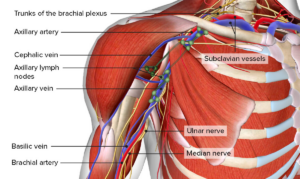Explanation
(Option B) Axillary Artery:
The axillary artery is a major blood vessel that supplies blood to the upper limb and the shoulder region. It is a continuation of the subclavian artery and becomes the brachial artery at the lower border of the teres major muscle. Given its location and significance in supplying the shoulder area, damage to the axillary artery would likely lead to bleeding in the upper shoulder area.
(Option A) Thyrocervical Trunk:
The thyrocervical trunk is a branch of the subclavian artery. It gives rise to several arteries supplying the neck and upper shoulder region, including the suprascapular and transverse cervical arteries. While it does supply blood to parts of the shoulder, it is less likely to be the source of bleeding in this scenario compared to the axillary artery.
(Option C) Maxillary Artery:
The maxillary artery is a major artery of the face and is a branch of the external carotid artery. It supplies deep facial structures, including the maxilla, mandible, and teeth, as well as parts of the nasal cavity and palate. It is not involved in supplying the shoulder region, making it an unlikely source of bleeding in this context.
(Option D) Brachial Artery:
The brachial artery is a continuation of the axillary artery and supplies blood to the arm. While it is crucial for blood supply in the arm, it is located further down the arm and is not typically involved in bleeding from the upper shoulder area. Damage to the brachial artery would not likely cause bleeding specifically from the shoulder.
(Option E) Subclavian Artery:
The subclavian artery is the major artery supplying blood to the upper limb and parts of the neck. It branches into the axillary artery, among other branches. While damage to the subclavian artery could lead to significant bleeding, it is less likely to be the source of bleeding specifically from the upper shoulder region compared to the axillary artery, which is directly involved in supplying that area.
Subject: General Surgery
System: Vascular System (specifically relating to arterial anatomy and bleeding)
Topic: General Surgery: Hemorrhage
Difficulty Level: Moderate
General Surgery: Hemorrhage
| Aspect |
Details |
Importance |
| Definition |
Hemorrhage refers to excessive bleeding from blood vessels, which can be classified as either external or internal. |
Understanding hemorrhage is critical for diagnosing and managing surgical emergencies. |
| Causes |
- Trauma (e.g., lacerations, fractures)
- Surgical complications
- Vascular disorders (e.g., aneurysms)
- Coagulation disorders (e.g., hemophilia)
|
Identifying the cause helps guide appropriate interventions and treatment. |
| Assessment |
- Clinical examination (vital signs, history)
- Imaging (ultrasound, CT scans)
- Laboratory tests (CBC, coagulation profile)
|
Proper assessment is essential for determining the severity of hemorrhage and treatment needs. |
| Management |
- Stabilization (IV fluids, blood transfusions)
- Surgical intervention (e.g., ligation, resection)
- Monitoring and supportive care
|
Effective management can prevent shock and improve patient outcomes. |
| Complications |
- Hypovolemic shock
- Organ dysfunction
- Death if untreated
|
Recognizing complications is vital for timely intervention and improved prognosis. |
| Prevention |
- Risk assessment
- Optimal surgical techniques
- Management of coagulopathy
|
Preventive measures can reduce the incidence and severity of hemorrhage during surgical procedures. |

Axilla Anatomy Diagram